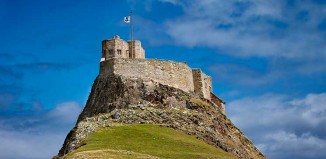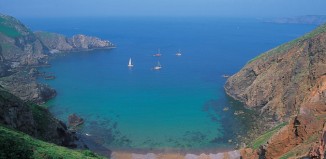Castle Cornet
Castle Cornet sprawls, impregnable-looking, over a small rocky islet some half a mile off the Guernsey coast – its massive grey outer walls linked to the harbour town of St Peter’s Port by a breakwater that was only built in the 19th century.
Archeological evidence suggests that the islet upon which the castle now stands has been used since the Neolithic period, and certainly by Roman times the natural harbour of St Peter Port was a busy town on the trade route between England and France. Following the Norman Conquest in 1066, England, Normandy and the Channel Islands were all part of the same kingdom, but in 1204 King John of England lost Normandy to the French King Phillipe Auguste. Guernsey and the other Channel Islands however remained under the English crown, and due to St Peter Port’s strategic position and preeminence as a natural harbour, Castle Cornet was built to protect it. The word Cornet probably refers to a family of merchants with this name, who are known to have lived on Guernsey at the time the castle was built.
Work first began on the castle around 1250, on the highest part of the islet, with the gatehouse being reached from the north by a rocky path from the shoreline. At this time the fortifications included a large square tower to the south, known as the Tour Carré, and a half round tower to the west – and there was a chapel beside the gatehouse.
During this period, and throughout the 14th century, the Channel Islands came under frequent attack from the French (as much as a quarter of St Peter Port’s population was killed in one attack alone in 1294), and over the years the castle sustained considerable damage. In 1338 the French captured Castle Cornet, and held it for seven years until Godfrey d’Harcourt was sent with a small force to take it back for England. A large Donjon or Keep was built in the 15th century along with a Great Hall and a Barbican, and in 1435 the first tower built specifically to take cannon was added, the so-called Gunner’s Tower, with a curtain running wall between it and the Barbican.
In the 16th century under Henry VIII and into the reign of Elizabeth I, the Castle’s defenses were strengthened to bring them in line with the capabilities of modern weaponry, which, by then, included gunpowder and artillery. This started with the addition of platforms for cannon and the construction of the so-called Mewtis Bulwark (named after the Governor at that time, Sir Peter Mewtis). Work continued under Governor Sir Thomas Leighton, who entrusted the reconstruction to Paul Ivy, the foremost military engineer of his day. He had also been responsible for strengthening Dover Castle and was the first to introduce contemporary Italian ideas of fortification into Britain. It was Ivy who added the massive outer walls which surround the castle today, with their formidable bastions and bulwarks.
During the Civil War – though the island of Guernsey supported the Parliamentarians – the then Governor Peter Osborne remained loyal to the King. As a result Osbourne and a small force of men were besieged in Castle Cornet for almost nine years, from 1643 to 1651, receiving supplies by boat until these were finally cut off, forcing Osbourne’s surrender. After the close of the Civil War, Sir John Lambert, one of the foremost Parliamentarians was imprisoned in the castle, where he spent much of his time gardening and is said to have introduced the Guernsey Lily to the island.
One of the most prominent parts of the Medieval Castle, the Keep, is today conspicuous by its absence. Used as a gunpowder store, it was blown to pieces when struck by lightning during a storm on the night of December 29th, 1672 – throwing the then Governor Lord Hatton, still alive and in his bed, onto an outer wall but killing his young wife and her maidservant as well as Hatton’s mother, among others, though his two young children miraculously survived. The Governor’s Residence and the Chapel were also destroyed in the explosion, and since that date no Governor has lived in the Castle, preferring to take up residence in St Peter Port itself.
Although by the 18th century the development of increasingly powerful artillery meant that the Castle was in range of the high ground above St Peter Port, it remained an important fortress armed with over 70 guns, and rebuilding continued with the construction of the Upper Barracks (1745), built as married quarters, as well as two bombproof barracks beneath surviving sections of the Medieval Castle. A new fortress was built at the southern end of St Peter Port, Fort George, completed in 1812.
During the German occupation of Guernsey in WWII the Castle became the Hafenschloss (Harbour Castle), and was garrisoned by an anti-aircraft unit. Concrete gun turrets and emplacements for Flak anti-aircraft guns were built on its walls, and several concrete bunkers added.
In 1947, Castle Cornet was given to the people of Guernsey by King George VI, in recognition of their loyalty to Britain during the two World Wars.
During a visit today, there is a huge amount to see inside the Castle. ‘People are surprised to find the Castle is much larger on the inside than it looks from a distance – you can easily spend 5 or 6 hours there,’ says Jason Monaghan, Museums Director, Guernsey Museums and Galleries. ‘Perhaps the top draw for visitors is watching the Napoleonic cannon being fired at noon each day. In the future we would like to open up the Citadel – a network of bunkers, rooms and tunnels under the very heart of the Castle; these have not been used since the Cold War ended and visitors have never been allowed down there.’
The ‘Noon-Day Gun’, a 1799 32-pounder of Blomefield pattern, occupies a terrace between the former Guard House – now the ticket office and shop – and the Upper Barracks. It is mounted on the only original wooden garrison carriage remaining in the castle. The tradition of firing a gun at noon dates from at least the beginning of the 19th century (a second gun was also fired in the evening to recall troops to the barracks). The practice ceased in 1923, but was reintroduced in 1974. It is fired daily – at 12.00, as you might expect – using a saluting charge detonated electronically.
Within the castle are five museums, all of them well worth visiting.
The Story of Castle Cornet Museum, housed in the Lower Barracks next to the ticket office, does a good job of setting the site’s 800 years of history in context, and should be your first port of call once inside the castle. The various displays include the story of a mysterious skeleton discovered in the castle during archaeological excavations, with a Spanish gold coin from 1614 (a pistole, perhaps better known as a doubloon) in the area of its stomach.
The Maritime Museum, housed in the Upper Barracks, provides a fascinating overview of Guernsey’s rich maritime history – from the story of a Gallo-Roman- wreck found in the mouth of St Peter Port’s harbour in 1985, to a complete sail-powered fishing boat typical of Guernsey, built around 1930.
On the first floor of the old Hospital Building (1746) is the Royal Guernsey Militia Museum, opened in 2011, which tells the story of the Island Militia from its 13th century origins up to the early 20th century, when it was disbanded just before WWI. On the ground floor of the same building is the RGLI Regimental Museum, covering the history of the Royal Guernsey Light Infantry, which formed with the disbanding of the Militia.
A scattering of small, well-manicured gardens bring a splash of unexpected greenery to the castle, each from a different period of its history – from the 19th century Gunner’s Garden, a privilege of the Master Gunner illustrating the importance of his position, to the 18th century Governor’s Garden below the Mewtis Bulwark, with its neat topiary.
Sheltered from the sea breezes by the castle walls, it offers a surprising moment of calm within the confines of this enduring island fortress.
Castle Cornet is open March to November. Tours of Castle Cornet start from outside the ticket office (Guard House) daily at 10.30.Tel: 01481 726518. www.museum.guernsey.net
Visit Guernsey: Tel: 01481 723 552. www.visitguernsey.com








